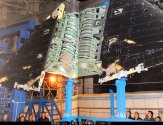You are using an out of date browser. It may not display this or other websites correctly.
You should upgrade or use an alternative browser.
You should upgrade or use an alternative browser.
J-35A fighter (PLAAF) + FC-31 thread
- Thread starter ACuriousPLAFan
- Start date
I'd say Shining instead of Glorious.J-35A = 耀龙 = Yàolóng = Glorious Dragon
IIRC the J-35A is at 17.7m.
They apparently did a bit of finessing going from the V2 to the J-35/A to make space for thicker payloads, illustrated here:
View attachment 139880
Seen above, by raising the engine bays and stretching the fuselage longer, the s-ducts can be finessed to take up less of the IWB's space. Thus, it's capable of storing a larger (pun intended) variety of payloads:
View attachment 139881
Top one is a side view of the J-35/A's IWB. The one under it is the J-20's. The third one is both overlaid on top of each other, and the final image is where the hypothesized payload was taken from.
Another comparison:
View attachment 139882
The choice of medium-thrust class engines for the J-35/A is even more justified here since the s-ducts can be thinner compared to the J-20.
Source for the J-35/A's IWB:
View attachment 139883
The inlet geometry potentially allowing for a IWB that is a bit deeper is something I have no opinion on, it seems plausible and the paper is quite a good find.
However I'm less sure about their comparison of the two aircraft directly -- the J-35A measures at 1892 pixels long, the J-20 at 1950 pixels long.
Even if we use the J-35A's length as 17.7m, the J-20 will come out to only 18.24m long, meaning in that comparison the J-20 is way underscaled.
Where is the room for inlet right in front of the engine in that drawing?
I'm not sure what you mean by that, because in that specific drawing for J-35A at least (leaving aside how well scaled it is with J-20), the overall depiction of the weapons bay length seems consistent with the ventral view that we have, and also consistent with what we know about the engine's length and geometry.
Potentially like this:

no A2A fuelling pod ?
There is an aerial refuelling probe that is retractable and hidden on the right side of the nose.
You can look through the recent pictures yourself to find them, but it's there.
View attachment 139922
Lateral & ventral comparison of the J-20 and J-35A - I calibrated both images using the pilots' helmets and obtained a consistent length of around 17.7 meters for the J-35A assuming a J-20 length of 20.6 meters (a stat individually corroborated with comparison with flankers). The weapon bays appear to be around the same width although J-20's appear to be slightly longer. The red line on J-35A's nose indicate a possible radome position assuming the same radar as the J-20.
J-20 is 21.1 meters as per AVIC.
J-20 is 21.1 meters as per AVIC.
Do we have a source on that? I recall something about AVIC giving us a number some years ago but I could never fully recall it.
The engine inlets are placed high up to the upper side of the fuselage. The lower part of the engine compartment is not taken by the engine. This is also the cases of F-22 and F-35 who looks shortter than J-20. Looking from the side, the engine is almost (90%) above the weapon's bay.Where is the room for inlet right in front of the engine in that drawing?

Hello, have any "dragon" names older fighters like J-7 and J-8 too?OK, let's sum up the nicknames... Additions or corrections welcomed.
J-10 = 猛龙 = Měnglóng = Vigorous Dragon
J-11 = 应龙 = Yìnglóng = Responsive Dragon
J-15 = 飞鲨 = Fēishā = Flying Shark
J-16 = 潜龙 = Qianlóng = Hidden Dragon
JF-17 = 枭龙 = Xiāolóng = Fierce Dragon
J-20 = 威龙 = Wēilóng = Mighty Dragon
J-35 = 蓝鲨 = Lánshā = Blue Shark
J-35A = 耀龙 = Yàolóng = Glorious Dragon






